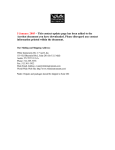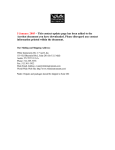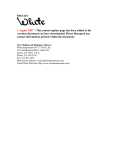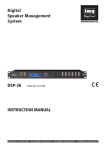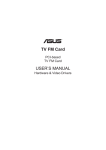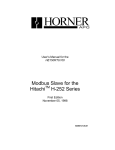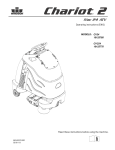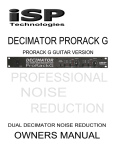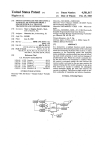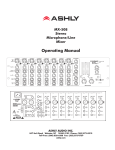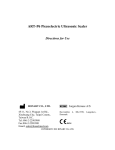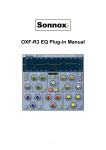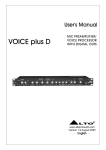Download Models 4650 and 4660
Transcript
5 January 2005 – This contact update page has been added to the Acrobat document you have downloaded. Please disregard any contact information printed within the document. Our Mailing and Shipping Address: White Instruments Div. C Van R, Inc. 1514 Ed Bluestein Blvd., Suite 201 (for U.S. Mail) Austin, TX 78721 U.S.A. Phone: 512-389-5358 Fax: 512-301-3932 Main Email Address: [email protected] World Wide Web Site: http://www.whiteinstruments.com/ Note: Repairs and packages should be shipped to Suite 202 Models 4650 and 4660 One-Third Octave Active Equalizers featuring Slide Controls This document was generated from the original printed 4650 and 4660 Data Sheets, Brochures and Users' Manuals. CONTENTS CONTENTS ........................................................................................................................ 1 Models 4650 and 4660 - One-Third Octave - RC Active Equalizers ................................. 3 Photograph - Model 4650................................................................................................ 3 Photograph - Model 4660................................................................................................ 3 Models 4650 and 4660 Specifications ............................................................................ 6 Models 4650 and 4660 Users' Manual ................................................................................ 8 INTRODUCTION:.......................................................................................................... 8 WHAT YOU PAID FOR: ............................................................................................... 8 JUMP START................................................................................................................. 8 WARRANTY POLICY ................................................................................................ 10 HOW TO OBTAIN WARRANTY REPAIRS ............................................................. 10 HOW TO OBTAIN OUT - OF - WARRANTY REPAIRS: ........................................ 10 UNPACKING: .............................................................................................................. 11 THE PAGKAGE SHOULD CONTAIN THE FOLLOWING: ................................ 11 ACCESSORY INSTALLATION ................................................................................. 11 ACCESSORY TRANSFORMER p/n 4622 INSTALLATION: .............................. 11 INSTALLATION PROCEDURE:............................................................................ 12 ELECTRICAL CONNECTIONS: ............................................................................ 12 ACCESSORY SECURITY COVER (P/N 4623) INSTALLATION: ...................... 13 INSTALLATION PROCEDURE:............................................................................ 13 HOW TO RACK MOUNT THE EQ & SECURITY COVER:................................ 14 CONNECTIONS TO THE SOUND SYSTEM ............................................................ 14 UNBALANCED OPERATION.................................................................................... 15 BALANCED OPERATION ......................................................................................... 16 1 MODEL 4650 SPECIFIC: ........................................................................................ 16 AC POWER and POWER SUPPLY............................................................................. 17 MAINS VOLTAGE: ................................................................................................. 17 POWER SUPPLY:.................................................................................................... 17 FUSE: ........................................................................................................................ 18 POWER CORD:........................................................................................................ 18 MUTE RELAY: ........................................................................................................ 18 FRONT PANEL CONTROLS AND FEATURES:...................................................... 18 FILTER CONTROLS: .............................................................................................. 18 LED and LED COLOR TRANSITION CONTROL: ............................................... 18 POWER:.................................................................................................................... 19 SIGNAL: ................................................................................................................... 19 HEADROOM:........................................................................................................... 19 CLIPPING:................................................................................................................ 19 OUTPUT GAIN CONTROL: ................................................................................... 19 EQ IN/OUT SWITCH:.............................................................................................. 21 REAR PANEL CONTROLS AND FEATURES: ........................................................ 21 MAINS VOLTAGE SWITCH:................................................................................. 21 SHIELD GROUND LIFT SWITCH:........................................................................ 21 GROUND TERMINAL: ........................................................................................... 22 FILTERS: ...................................................................................................................... 22 HIGH and LOW-PASS FILTERS: ........................................................................... 22 ONE-THIRD OCTAVE FILTERS: .............................................................................. 23 Component Diagram ..................................................................................................... 24 Block Diagram .............................................................................................................. 25 2 Models 4650 and 4660 - One-Third Octave - RC Active Equalizers Photograph - Model 4650 Photograph - Model 4660 Ultimate Field Serviceability The 4650 is designed to be quickly and easily serviced in the field. Access to ALL operational amplifiers is obtained through the front panel, WITHOUT removing the unit from the rack and WITHOUT disturbing the equalization settings. Field service is as easy as ONE-TWO-THREE! Ultimate Customer Support Although the 4650's ICs are fairly common, spare, burned-in and selected parts are always available from White Instruments. Should you have a control problem we will lend you a Control Module while we repair yours. 3 Hi... we're White Instruments from Austin, Texas, U.S.A. One-Third Octave Filters The Model 4650's 28 One-Third Octave Filters sum together without ripple. That is to say their individual bandwidth was engineered to be sufficiently wide, that when two adjacent filters are adjusted to cause a boost or cut response with an amplitude of 12dB, its frequency will be centered between the two adjacent filters. There will not be a significant return lobe (the new response will have a smooth top or bottom). For that matter a shelving response at +12dB or – 12dB, which looks like it was drawn with a straight edge, can be created using all of the filters. You are about to read about our latest equalizer, the Model 4650, which is truly a remarkable and elegant product (if we do say so ourselves), as it features some fresh new ideas in the design and construction of a OneThird Octave Graphic Equalizer. Model 4650 – A Professional Tool The Model 4650 is a tool for audio professionals. By definition it will be installed in a system upon which someone will depend for their livelihood. As a tool it will be used constantly and sometimes abused. Another way of putting it is, that upon installation it will have entered a contest with its owner to see who survives! Like all White Instruments' equalizers, a great deal of care was taken in the design and implementation of the filters to assure that they would be symmetrical between boost and cut, have uniform bandwidth and extremely tight frequency tolerances. The family of filter's plot tells the story. From a manufacturer's viewpoint (if he cares) there is only one way to hedge this bet. Build in quality from the ground up and build in serviceability. We care! The task begins with a clear understanding of the product's applications, features and performance necessary to match the need. 4 High and Low-Pass Filters Connectors The Model 4650 is equipped with fixed, 12dB/Octave band limiting filters. The High-Pass (low-cut) filter is set at 16 Hz; the Low-Pass (high-cut) filter is set at 35k Hz. The benefit is a linear roll-off of subsonic and ultrasonic components in the signal which, if present, can rob the amplifiers of a substantial amount of power and cause distortion. XLR with redundant 0.25" TRS Jacks are wired according to the DIN Standard: Pin 2, High. Internal Power Supply The internal power supply will operate on 115 or 230 VAC, 50/60 Hz. It is switched on the rear panel. Gain A Few Words About Phase Up to 10dB of gain is available and controlled from the front panel. You will find this to be a handy feature when you use a great deal of cut equalization. Every filter manufactured by White Instruments for audio equalization applications is a Minimum Phase Filter. In fact, we have yet to run into a filter manufactured by anyone for this application which is not minimum phase. LED Indicator – One Light Metering This idea came right out of Rock N Roll. A single two color LED (green/red) indicates the level status of the input or the output of the 4650 (whichever is greater). The transition from green to red is controlled by a single rotary pot from the front panel. The color transition may be set to occur at a level from – 20dB to +18dB depending on your particular setup and what you desire to monitor. One glance at a stack of equalizers in the monitor rack, for instance, indicates a go or no go condition, instantly. Phase shift of an audio signal passed through a filter is a physical fact of life. The amount of shift is mathematically predictable once the parameters of the filter are known. The amount of phase shift will be identical through filters with identical responses regardless of whether the filter was derived actively, passively or acoustically. The Noise Specification We enjoy a worldwide reputation for being the noise performance kings of the equalizer business. Low noise is and always has been our main circuit design criteria. Quality Components and Construction Great electrical performance would be a moot point without components and construction of equal quality. We specify our noise as worst case, which in this instance is –80dB (referenced to 0.775 volts). Here are some of the features you will be depending on. Many equalizer manufacturers specify their noise with all filter controls set flat. While these products might make fine line amplifiers, their noise spec is seriously degraded the moment their one-third octave filters are used. Circuit Boards: Well Supported; G-10 Glass Epoxy; Wave Soldered; Solder Masked; Cleaned. Integrated Circuits: In Sockets; 50 Hour Incoming Burn-In; Tested and Hand Selected; 50 Hour Burn-In of Finished Unit Before Final Inspection. White Instruments, on the other hand, has developed a unique filter summation network for our R-C active equalizers, which we are certain will be imitated in the near future. This, combined with operational amplifiers which have been hand selected for low noise and careful attention to construction details, yields an extremely quiet graphic equalizer. Resistors: Precision Metal Film and Laser Trimmed Thick Film. Linear Controls: 60mm (longest control you can get into a 3.5" package); Dust Shield; Custom Taper; Center Detent. Feel free to use as much EQ as you like with the Model 4650. You will notice it is markedly quieter than any other graphic you may have used (with the exception of one of our costlier L-C active models). Chassis: High Quality Aluminum Alloy; Precision Fabricated For Square and Fit; Captive Threaded Fasteners (no sheet metal screws); Fasteners Treated to Resist Corrosion; Brushed to Deburr Outside and Inside; Primed and Painted with Catalytic Acrylic Resin. Line Driving Capability A Signetics 5532 Operational Amplifier, known for its current handling capability, is used as the output buffer. It will drive a 600 ohm load to +20dB so you can hang a substantial stack of power amps on the 4650's output. Burn-In and Final Inspection: The semi-assembled equalizer is burned-in for at least 50 hours with a pink noise signal applied and a load. A technician then checks every filter, every function and every connection. When satisfied that the unit meets specs, he assembles the rack mounting ears and covers. He then turns the unit over to shipping who give it a final cosmetic check before packing. D.O.A.'s from White Instruments are practically nonexistent. An optional transformer kit, which balances and isolates both the input and output, can be easily installed in ten minutes. 5 After The Sale The Model 4650 carries a One Year, limited, parts and service Warranty. A very small percentage of our customers has ever had to use our warranty. Because we realize that your livelihood depends, in part, on the continuing performance of our product, and that our livelihood depends a great deal upon your satisfaction and repeat business, we stand ready to respond, instantly if we can, to service or field problems related to our products. A very small percentage of our customers has ever had to call our hand on this point. Those who did were more than satisfied with the results. Models 4650 and 4660 Specifications Frequency Range: 20Hz ( –2dB) through 20kHz ( –1dB), typical. All 1/3-octave filters set at center detents. Recommended Operating Level: OdBu (0.775 volts RMS). Maximum Operating Level: +20dBu into 600 ohms (re. 0.775 volts). Noise: Better than –88dBu (re. 0.775 volts) at unity gain, 20kHz bandwidth. Worst case. Distortion: Less than 0.05% THD into 600 ohms, 20kHz bandwidth. Filter Type: R-C active, single-pole pair. Filter Control Centers: 28 one-third octave filters on I.S.O. standard frequency centers from 31.5Hz through 16kHz. Filter Center Frequency Tolerance: ± 5%. Filter Controls: 60mm linear potentiometers with center detents and integral dust covers. Filter Control Range: ±12dB at center frequency. Detent at OdB ±0.5dB). EQ In/Out Switch: Front panel mounted. Bypasses 1/3-octave filters only. High-Pass Filter: 4660 12dB/octave response Continuously variable between 17Hz and 180Hz. 4650 Fixed at 17Hz. 6 Low-Pass Filter: 4660 12dB/octave response. Continuously variable between 5.3kHz and 26kHz. 4650 Fixed at 26kHz. Gain: 0dB to +10dB. Continuously variable. Power/Signal/Headroom/Clip Indicator: Two color LED. Monitors input and output. Lights green for power and signal below threshold. Lights red for signal above threshold. Threshold is continuously adjustable between –20dBu and +18dBu via front panel control. Connectors: XLR and redundant 0.25" TRS jacks. Shield Lift Switch: Rear panel mounted slide switch lifts both input and output shields from AC ground. Input/Output Circuits: Single-ended buffers. Optional balancing transformer assembly (p/n 4622) balances both input and output. Input Impedance: 20k ohms. Output Impedance: Less than 100 ohms. 350 ohms with optional transformer assembly (p/n 4622). Power Requirements: 90 – 130/180 – 260 volts, 50/60Hz AC. User selectable on rear panel. Mute Relay: Mutes audio on power-up and power-down. Dimensions and Weight: 3.5" (8.9 cm) X 19" (48.3 cm) (rack mount) x 5" (12.7 cm). Approximately 7 lbs. (15.6 kg). Finish: Black painted brushed aluminum. White nomenclature. Accessories: Input/output balancing transformer kit, p/n 4622. Matching metal security cover, p/n 4623M. Clear plastic security cover, p/n 4623C. We reserve the right to improve our products and to change features and specifications without notice 7 Models 4650 and 4660 Users' Manual NOTE: ALL REFERENCES TO 4650 IN THIS MANUAL ARE CORRECT FOR 4660 UNLESS OTHERWISE INDICATED. INTRODUCTION: CONGRATULATIONS! You have purchased one of the finest One-Third Octave Graphic Equalizers that money can buy! This INSTALLATION NOTE is intended to help you get your new equalizer installed and working. Please fill-out and return the User's Service Card packed with your equalizer. Your comments are always appreciated. Recording your ownership of this product with us could help you recover it in the event it is lost or stolen. WHAT YOU PAID FOR: By choosing our product over our competition's you have made a direct contribution to the livelihood of everyone at White Instruments. In all likelihood your new equalizer will be installed in a system upon which you or others depend for a living. We believe we must continue to earn your trust. White Instruments has manufactured your new equalizer to the highest possible quality standards within the given realm of economic reason. We want you to be happy with your purchase over the long term. We want you to continue to purchase and recommend our products. We believe we have built our reputation and business on customer satisfaction by offering quality products, personalized service, instant response to field problems and no hype. You, our customer, are the most important person in the world to us as a company. If you have any problems with this product, or if you have any questions please remember that we are as near as your telephone. JUMP START For our customers who would like to get their new equalizer into service without reading the entire manual. 1. Check to determine that you received everything you have paid for and that nothing appears to be damaged. 2. Check the setting of the AC Mains Voltage Switch on the rear panel. 3. Mount the equalizer in the rack. 4. We suggest that the front panel Gain Control be initially set to unity (full CCW) and that the LED Color Transition Control be set somewhere near the center. We also suggest the filters be set to their flat position. 5. Refer to the following drawings to become familiar with the equalizer's input and output circuits and their polarity. 8 6. Purchase or construct the appropriate input and output interface cables. Connect them to the equalizer. 7. Be advised that the equalizer is not equipped with a power switch. It is powered up whenever the appropriate AC is connected to its Mains Cable. The equalizer is, however, equipped with a mute relay which prevents it from passing a signal until the power supply is up and stable. It is advised that the power amplifiers be turned off or down before connecting the equalizer to AC power or removing/inserting input/output cables. 8. Connect the equalizer to AC power. 9 WARRANTY POLICY Your White Instruments Equalizer is Warranted against defects in manufacturing, workmanship and original components for a period of ONE YEAR from the date of purchase. During this period White Instruments will repair or replace the equalizer, at our option, so long as it has not been subjected to abuse. Abuse may be physical and/or electrical in nature. White Instruments will be the sole judge of this criteria. White Instruments is the only warranty repair facility in the United States. Outside of the United States, White Instruments Distributors are authorized to make Warranty Repairs. HOW TO OBTAIN WARRANTY REPAIRS The equalizer should be securely packed and shipped, prepaid, to White Instruments or one of its Authorized Offshore Distributors. A return authorization is not required. Our U.S.A. shipping address may be found on our web site. Contact the factory for the name and address of the Offshore Distributor nearest you. A copy of your sales receipt should be included to establish the warranty date. Without it we will have to rely on the serial number, which indicates when we originally shipped the equalizer to a dealer. A completed trouble report or letter detailing the equalizer's malfunction must be included. Your name, shipping address and telephone number must be included. Every effort will be made to complete warranty repairs within five working days of receipt of the unit. Your equalizer will be returned to you via best surface freight, prepaid. If you instruct us to return your equalizer via air freight, it will be shipped with freight charges collect. HOW TO OBTAIN OUT - OF - WARRANTY REPAIRS: Should the required repairs not be covered by our warranty you will be charged for parts and the labor required to repair the unit. Should you require an estimate of charges prior to repairing the unit you should notify White Instruments of this when returning the unit. Every effort will be made to complete the repair within five working days. The unit will be returned C.O.D. unless other arrangements have been made. As a service to our customers we do not consider our Repair Department to be a profit center. 10 UNPACKING: Carefully unpack and inspect your new equalizer for damage. Save the packing materials to assure safe transit to us in the event your equalizer should ever need factory service. Immediately report any damage to the carrier. Your equalizer was shipped with full insurance unless we were instructed otherwise. Although White Instruments is not responsible for damage in shipping we will assist you in quickly obtaining parts and/or repairs. THE PAGKAGE SHOULD CONTAIN THE FOLLOWING: One Model 4650 Equalizer. This Manual. Four Rack Mounting Screws. One User Service Card. ALSO... ANY ORDERED ACCESSORIES WHICH MAY OR MAY NOT BE FACTORY INSTALLED: 4622 Input/Output Transformer Assembly. 4623C Clear Security Cover with two rack mounting screws. 4623M Metal Security Cover with two rack mounting screws. ACCESSORY INSTALLATION ACCESSORY TRANSFORMER p/n 4622 INSTALLATION: The Model 4650 Equalizer may have its input and output transformer-isolated and balanced by installing the optional Accessory Transformer Assembly kit, P/N 4622. !! C A U T I 0 N !! This procedure should be referred to a qualified service technician as it requires opening the unit thereby exposing a possible shock hazard. The Accessory Input/Output Transformer kit, P/N 4622, consists of the following: TRANSFORMER ASSEMBLY: One sealed can containing one balanced input and one balanced output transformer. Four 6-32 hex nuts and four P6 lock washers for mounting. One set of instructions. (Duplicate of this section) 11 INSTALLATION PROCEDURE: The tools required are a 1/4" open end wrench and a flat blade screwdriver. 1. Disconnect the equalizer from AC power. 2. Disconnect the equalizer from the sound system. 3. Remove the equalizer from the rack. 4. Place the equalizer on a soft work surface. 5. Remove the equalizer's top cover as follows... A. Remove four 6-32, slotted, panhead screws from the top edge of the rear panel. B. Gently pry the top cover up and off with a small flat blade screwdriver or knife. BE CAREFUL NOT TO SCRATCH THE PAINT! 6. Press the plastic plug out of the transformer mounting hole from inside the rear panel. 7. Mount the transformer assembly as follows. A. Feed the transformer assembly's pigtail through the mounting hole from the outside of the equalizer. B. Align the transformer assembly for the printed label to read same as back panel. Insert into back panel. C. Secure the transformer assembly with the four supplied 6-32 hex nuts and lock washers. ELECTRICAL CONNECTIONS: 1. Note that the keyed MOLEX connectors will only mate correctly. 2. Disconnect the cable between the equalizer's filter board and input/out put connectors. 3. Connect the transformer's pigtail to input/output connectors' pigtail. 4. Connect the filter board's pigtail to the transformer's pigtail. 5. Install the top cover. 12 ACCESSORY SECURITY COVER (P/N 4623) INSTALLATION: The Model 4650 is normally supplied with its front panel flush with its rack mounting ears. The Accessory Security Cover (P/N 4623) is designed to mount over the rack mounting ears flush with the front of the rack. The rack mounting ears must be moved forward in order to recess the equalizer's front panel before installing the security cover. INSTALLATION PROCEDURE: 1. Place the equalizer on a FLAT surface. !! CAUTION !! Do NOT lift the equalizer off of this surface until BOTH rack mounting ears have been reinstalled. also... REMOVE ONLY ONE RACK MOUNTING EAR AT A TIME! The rack mounting ears hold the equalizer together. If both are removed at the same time it is possible for the equalizer to shift out of square. This would make the reassembly difficult. 2. Remove the rack mounting ear by removing the four 6-32, slotted, panhead screws. 3. Align the ear according to the following drawing. 4. Reinstall the four 6-32 screws as shown in the drawing. One drop of LOCTITE on each screw is suggested. 5. Tighten the screws before removing the other rack mounting ear. 6. Repeat the procedure for the other rack mounting ear. 13 HOW TO RACK MOUNT THE EQ & SECURITY COVER: l. Install the equalizer in the rack using the four screws in the four corners of the rack mounting ears. 2. Install the security cover using two screws in the middle of each rack mounting ear. CONNECTIONS TO THE SOUND SYSTEM The Model 4650 is connected to the sound system via two XLR connectors or two redundant 0.25" TRS connectors. Interface wiring to the equalizer should be high quality, two conductor, shielded cable terminated with the appropriate connectors. The equalizer is constructed so that the audio circuit can be floated within the chassis by use of the shield lift switch. The chassis is bonded to AC ground through the power cable. AC ground is also available at a screw terminal on the rear panel of the equalizer between the connectors. It is not the purpose of this manual to provide a dissertation on sound system interfacing, shielding, grounding and safety techniques. However, a few comments seem to be in order. NEVER remove the grounding lug from the AC power cable. To do so is dangerous (and unlawful in most jurisdictions)! Further it is unnecessary since the audio processed by this unit can be isolated from AC ground by setting the shield lift switch to the LIFT position. A good technical ground can and should be achieved through the proper design and installation of the AC system. The shield should not be thought of as part of the audio circuit. Rather, it simply helps to protect the audio circuit from airborne electrostatic and RFI noise. It is a generally accepted practice to connect the shield to AC ground at only ONE end of the audio cable. The other end should be left open or connected to ground through a .01 mfd capacitor. Interface cables, whether purchased or made, should be of the highest possible quality and treated with the same respect as any other fine audio component. Audio System Polarity: When a positive pressure is applied to the diaphragm of a microphone the loudspeaker should move outward. Although a DIN standard exists for the wiring of XLR connectors, many manufacturers, for one reason or another, still wire their XLR connectors contrary to the standard. For this reason you need to be aware of the polarity of every XLR connector in the sound system. White Instruments follows the DIN standard by assigning pin #2 as audio high or + and pin P3 as audio low or -. 14 UNBALANCED OPERATION The input to the Model 4650 is unbalanced (single-ended) and buffered. It loads at approximately 20k ohms. The input connection may be made through either the XLR female connector or the 0.25" TRS connector. The output from the Model 4650 is unbalanced (single-ended) and buffered. It presents a source impedance of less than 100 ohms. The output connection may be made through either the XLR male connector or the 0.25" TRS connector. The following drawings illustrate the circuitry and pin assignments for the Model 4650's connectors. A shield lift switch is provided on the rear panel of the equalizer to lift pins #1 of both XLR connectors as well as the sleeves of both TRS connectors from the chassis (and AC Ground). In the LIFT position circuit common will also be isolated from AC Ground. 15 BALANCED OPERATION What is a balanced audio transmission line? A balanced audio transmission line is a system which, like the shield, provides protection to the line from airborne, electrostatic disturbances or RFI noise. Two assumptions are made... The two audio conductors (wires) are in close proximity to each other. This is often accomplished by tightly twisting them together. Therefore it is assumed that the airborne electrostatic disturbance is imposed on both conductors, equally. Both audio legs (audio + or high and audio - or low) are referenced to a common point in the audio circuit. If the disturbance, in fact, is equally imposed on both audio legs and both audio legs are equally referenced to the common point (balanced), then the disturbance component of the signal does not generate an output signal. To some degree the disturbance is canceled. The fact that the input and/or output of an audio component is balanced is a function of its circuit design, not the audio interface. The audio interface (wire and connectors) can be configured to UNbalance a balanced circuit, but an UNbalanced circuit can not be balanced with the audio interface, alone. An UNbalanced circuit driving or terminating a balanced circuit will UNbalance the balanced circuit. MODEL 4650 SPECIFIC: When the Accessory Input/Output Transformer Assembly, P/N 4622, is installed the input and output will be transformer isolated and balanced (provided that the equalizer is connected to a balanced source and load). The input will load at approximately 20k ohms and the output will present a source of approximately 350 ohms. When the equalizer is loaded with 600 ohms, the maximum rated output with the transformers installed will be approximately 3dB less due to insertion loss in the output transformer. This loss all but disappears with loads of 10k ohms or higher. It should be noted that audio common is internally connected to pins no. 1 of the XLR connectors and the sleeves of the 0.25" TRS connectors. This path for audio common completely bypasses the accessory transformer, p/n 4622. This allows bonding of circuit common in the equalizer with that of its load and the component driving it. Further note that when the Shield Lift Switch is closed circuit common will be referenced to AC ground (green wire), pins no. 1 and the sleeves. 16 AC POWER and POWER SUPPLY MAINS VOLTAGE: The Model 4650's power transformer has dual windings which are selected by a switch located on its rear panel. The switch has two positions marked 115 and 230. In the 115 position the operating range is...90 – 130 V.A.C., 50/60 Hz. In the 230 position the operating range is...180 – 260 V.A.C., 50/60 Hz. POWER SUPPLY: The power supply produces regulated ±18 V.D.C. rails. 17 FUSE: !! C A U T I 0 N !! Use ONLY the specified Fuse. The fuse is a 0.25 AMP SLO-BLO for either voltage range. The size is 1.25" (313 or 3AG). POWER CORD: The equalizer is equipped with a captive 6' power cord with a NEMA 5-15P plug molded on the end. This connector may be changed for operation outside of the United States. MUTE RELAY: An audio mute relay closes to pass the audio signal when the power supply has had time to stabilize on power up. It opens to interrupt the audio signal on power down before the power supply has had time to decay. FRONT PANEL CONTROLS AND FEATURES: FILTER CONTROLS: The 28 One-Third Octave Filters are adjusted via 60mm linear potentiometers located on the front panel. Each filter control has a specified range of 24dB (±12dB) The zero position of each linear control is marked with a detent. LED and LED COLOR TRANSITION CONTROL: The Bi-Color LED can indicate several conditions: Power, Signal Present, Headroom and Clipping. Its color transition from GREEN to RED depends upon the highest signal level at either the input or output of the equalizer and the setting of the LED Color Transition Control. The transition circuit is peak detecting and nearly instantaneous. 18 POWER: Power is indicated by either a GREEN or RED light. SIGNAL: Signal Present is indicated by a RED light. The signal must have a level above -20 dBu* in order to be detected. In order to detect a signal with a level of -20 dBu the LED Color Transition Control must be in the full counter clockwise (CCW) position. As the control is turned clockwise (CW) the threshold at which the LED will change from GREEN to RED is raised above the -20 dBu minimum setting. * dBu = 20 log V/.775 = dBm with a 600 ohm load HEADROOM: Headroom is the difference between clipping level and the average signal level. The Model 4650 clips at approximately +20 dBu. When the control is in its full CCW rotation a RED light would indicate approximately 40 dB of headroom. When the control is in its full CW rotation a RED light would indicate approximately 2 dB of headroom. If the control were set at 0 a RED light would indicate approximately 20 dB of headroom. CLIPPING: If the control is set in its full CW rotation and the light is RED the equalizer is clipping. OUTPUT GAIN CONTROL: Up to 10 dB of GAIN can be added to the output signal (in addition to the gain realized from boost equalization). In the 0 position the equalizer is set for UNITY GAIN. That is with all of the onethird octave filters set to their detents the output signal will approximately equal the input signal in level. Again with all of the one-third octave filters set on their detents and the Output Gain Control set on 10, the output signal will be approximately 10 dB greater than the input signal. During the equalization process (using the one-third octave filters) gain is added or lost through the spectrum covered by the filters used. A great deal of care should be taken when using additional output gain. It is quite easy to use too much and clip the equalizer. This is even more likely when a great deal of boost EQ is used. 19 20 EQ IN/OUT SWITCH: In the OUT position the EQ In/Out Switch connects the Input Buffer to the Output Buffer through the fixed High and Low-Pass Filters and the variable gain stage thus by-passing the One-Third Octave Filters. Since the EQ is by-passed a level change might be noticed when using this control. This depends entirely upon the settings of the One-Third Octave Filters. REAR PANEL CONTROLS AND FEATURES: MAINS VOLTAGE SWITCH: !! CAUTION !! Always make certain of the AC line voltage you are connecting to. If the switch is set on 115 VAC and the equalizer is connected to 230 VAC, the unit will be damaged. SHIELD GROUND LIFT SWITCH: This switch is provided to disconnect the Shields (pins no. 1 of the XLR connectors and the sleeves of the 0.25" TRS connectors) and circuit common of both the Input and Output interfaces from AC Ground. When this switch is in the LIFT position pins no. 1 of the XLR connectors, the sleeves of the 0.25" TRS connectors and circuit common will be isolated from AC Ground. When this switch is in the EARTH position Audio Common will be connected to AC Ground (green wire) and the chassis of the equalizer. Please refer to the following manual sections: UNBALANCED OPERATION, BALANCED OPERATION and the CIRCUIT BLOCK D1AGRAM 21 You have three options for draining the shield conductor. First: You may leave it unconnected at the connectors and connect it directly to the Ground Terminal. Second: You may drain only through Audio Common by leaving the Shield Ground Lift Switch OPEN and connecting the shield conductor to the connectors. Third: You may drain through both Audio Common and AC ground by CLOSING the Shield Ground Lift Switch and connecting the shield conductor to the connectors. SHIELDS are usually connected at inputs and left open at outputs. GROUND TERMINAL: The Ground Terminal (screw terminal located between the connectors) is bonded directly to the Chassis and the Ground Wire of the AC Cord (green wire). It is not connected through the Shield Ground Lift Switch. This terminal provides a handy facility for bonding the chassis of the equalizer to those of other components in the sound system. When doing this, however, care should be taken to avoid ground loops between chassis bonding to ground and the internal bonding to AC ground. FILTERS: HIGH and LOW-PASS FILTERS: The Model 4650 is bandlimited by a fixed High and Low-Pass filter. These filters attenuate unwanted subsonic and ultrasonic signals which would otherwise be amplified. The response of each filter is 12 dB per Octave. The -3 dB point of the High-Pass Filter is set at approximately16 Hz and the -3 dB point of the Low-Pass Filter is set at approximately 35 kHz. 22 ONE-THIRD OCTAVE FILTERS: The Equalizer features twenty-eight filters on I.S.O. (International Standards Organization) One-Third Octave Frequency Centers from 31.5 Hz through 16k Hz. The range of control for each filter is 24dB (±12dB). Although the filters are centered on one-third octave frequencies their actual bandwidth is considerably greater than one-third of an octave. If this were not the case adjacent filters would not sum together gracefully. This would make ripple free shelving responses, for example, impossible to achieve. The bandwidth of the filters was selected as follows... When two adjacent filters were adjusted to create a response centered between them at an amplitude of 12 dB, there would be less than 0.25 dB of ripple. 23


























